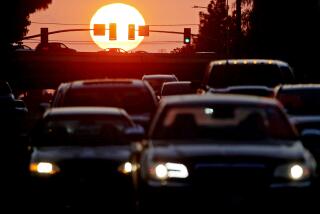Traffic: A Capital Need to Get Rolling
- Share via
Let the good times roll!
There’s a serious development message in that all-American sentence. Emphasis has to be placed on the word roll, meaning transportation and the ability to get from one place to another.
America’s current and future prosperity faces a seldom articulated threat--winding up on a freeway parking lot or being the victim of the frustrating crawl from one traffic light to another.
Healthy commercial and residential real estate developments require adequate transportation. Tenant decisions to lease office space inevitably depend on supposed attractive transportation access for employees and customers. So do home purchases. Who in America buys a new or existing house without inquiring thoroughly about the commuting situation?
Aware, both as a resident and through studies of the traffic clogging the Washington area, C. Kenneth Orski recently offered advice on national traffic tie-ups beyond the unsuccessful tactic of building more highways and widening roads.
As head of Urban Mobility Corp. in the District of Colombia, Orski cautioned an Urban Land Institute audience: “At best, increased highway capacity affords ephemeral relief.”
What’s the answer? Orski sees substantial relief in limiting road traffic through “demand management (DM).” This strategy encourages individuals to change their movement habits--thereby reducing peak-hour demand on street and highway facilities. He contends that “DM” can bring badly needed relief and have “an immediate impact, unlike new roads, which take years to construct.”
Fortunately, the tools of “DM” are available and in some use. We all know about the varied forms of ride sharing--car pools, vans, subscriptions buses. We also know about mass transit, variable work hours, local circulation systems and even “automobile disincentives,” such as ridiculously high parking fees (about $6 to park for a lunch in downtown D.C.).
Orski concedes that the keys to traffic management and/or traffic mitigation are the methods of using those tools.
As one whose livelihood is concerned with traffic management, Orski produces strong arguments for action in the private sector because inaction “may invite political pressure for more drastic solutions, such as building moratoriums or restrictive growth controls.” Both have surfaced already in this traffic-flooded area.
Citing the effectiveness of strong traffic management associations set up at the behest of commercial property owners and developers, Orski noted that traffic management groups already have had some success in the heavily clogged Tysons Corner area on the Washington Beltway in Northern Virginia.
He also mentioned Pleasanton, Calif., where a local ordinance requires developers and employers to reduce single-occupant auto trips during peak hours by 45% over four years. Mostly, shifting work hours is doing the job.
Orski admits that traffic management does not fit a common mold. Each plan must be individually tailored, but they all focus on concerns with a voice for leadership and advocacy; traffic mitigation through ride sharing and public transportation; providing services, such as parking and shuttle systems, and a positive mobility image by promulgating the effectiveness of the traffic mitigation tools being used.
Can a private traffic management association really do a job and mitigate traffic without government action? Here’s one seasoned view:
“As a private developer and as a person who often must be alone in his car to get to appointments and meetings, I know that the fundamental solution lies with individuals. Each of us must decide to do something about mitigating traffic. I have learned to use rapid transit Metro whenever possible and to go into downtown early and leave late when I’m using my own car,” says Justin Hinders, who lives at Tysons Corner but has his office in the District.
“I agree on the private approach and the personal response,” said realtor Wallace B. Agnew. “But there’s no way that you can unclog Washington, D.C.-area traffic without more participation from the federal and local governments.”
More to Read
Sign up for Essential California
The most important California stories and recommendations in your inbox every morning.
You may occasionally receive promotional content from the Los Angeles Times.













